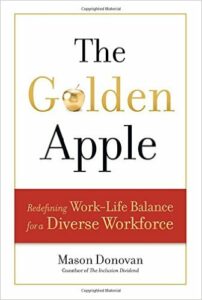The Changing Nature of Work
How we work is changing. Technology is ushering in new possibilities. New generations enter the workforce with different expectations. With all the changes in play, there are some things that stay the same: the desire for fulfillment and purpose, the need to balance the professional with the personal.
Mason Donovan tackles these challenges in his new book, The Golden Apple: Redefining Work-Life Balance for a Diverse Workforce. Mason is managing partner at The Dagoba Group, a New England-based diversity and inclusion consultancy. I had the opportunity to ask him about the changing nature of work, including generational changes, balance, mindfulness, and inclusion efforts.
Achieve Greater Satisfaction with Balance
Is work-life balance possible? Why is it so important?
Work-life balance is possible. There are a lot of gurus out there that say it is not in order to capture your attention in this crowded field. Emphasis is on the word balance. If you ever walked on a high beam or anything else in which you needed to physically balance yourself, you most likely fell off a few times. Your balance will fall off to one side or the other. It is important that you anticipate for these moments of imbalance, so you have a plan to get up.
Achieving balance will make you more productive in and out of the workplace. It will enrich your relationships and allow you to achieve greater satisfaction in life.
How is finding your purpose related to achieving balance?
In the book, I tell the story of executives on an interpersonal retreat climbing a mountain. Their primary purpose was to reach the summit without talking about business. The objective was for them to get to know each other better personally and share an accomplishment. Without spoiling the story, their original goal is interrupted because they lost their purpose.
In order to know where you are going in life, it is important to understand why you are going there. Work-life balance is no exception. Only a handful of people actually stop and reflect on why they get up every day to spend the majority of their waking life in an organization. When that somewhat simple-but-necessary reflection does not take place, you will default to acquiring things and making money, which almost inevitably leads to the golden handcuffs phenomenon. You work more because you have to make more money. You make more money so you can acquire things that require you to work more.
There has been a societal shift in why individuals engage in work. Part of that shift is due to generational changes, while for others it was their awakening due to the Great Recession. Aligning your personal purpose in life with your work and organizational purpose will help you eliminate all of the noise that does not fit that purpose. Balance comes from awareness. In The Golden Apple, I provide simple exercises to not only develop, but also align your purpose at each level.
Understand Generational Change
What are you finding in terms of generational changes? What are the new generations demanding at work? What’s the best way for current leaders to respond?
It is important to note that we are all unique individuals but are influenced by our shared group memberships such as our generation. Clumping everyone together and solely defining them by generational attitudes can overgeneralize any particular person. It is helpful to understand the influence of generational membership, which will give you a starting point when discovering their individuality.
Each generational cohort has a defining moment in the shaping of their shared psyche. When it comes to employment, for Generation X it was the broken promise of the organizational loyalty which fostered the cradle to grave jobs their parents subscribed to. Millennials were highly influenced by the Great Recession which ushered in massive layoffs, foreclosures and lowered career expectations. These defining moments create a collective influence on how cohorts view the work-life equation.
PwC’s NextGen study uncovered a generational shift when it came to work and personal engagement for their Millennial population. Uncovering this shift was important to them since by the year 2020, they expect that fully 80% of their employees will be Millennials. In short they found this group was far less likely to give up their personal life today for the prospect of a partnership down the road. The value structure was shifting more towards experiences than acquiring things.
Interesting to note is how this new value structure is also being reflected in Baby Boomers. The Great Recession robbed them of the ability to retire early as they saw their investments fail. It required them to reassess what they valued in life: time or things. Most have decided to choose to have life experiences in the time they have remaining. Downsizing acquisitions and upsizing experiences has become the trend for this generation.
Leaders need to better understand the value they offer to their current and future employees. By integrating work-life balance into their overall package, they will increase engagement and retention. They should look at this challenge through a holistic lens so they do not perceive it simply as a specific generational or gender issue. Policies and practices should be geared towards an inclusive solution that impacts the overall workforce.
Mindful Practices
Vacation. Why is taking it so important? How do you help organizational cultures that struggle in this area?
Taking vacation is not so important if you cannot be fully present when you are off the clock. There has been an unintended culture of working vacations, which never allows an employee to fully disconnect. Organizations struggle with vacation because they typically employ the Simon Says approach, which has leaders telling their staff to take vacations, but then frowning when they do or fully engaging them when they are on vacation.
Leaders need to model the behavior they want to see in their employees. It is not enough to simply talk the talk. If they want refreshed employees that will be more productive, innovative and content, then that requires employees who can fully disconnect. In The Golden Apple I speak at length of how to break the Simon Says approach, which will allow the organization to create a culture of intended action instead of policy propaganda.
What’s a mindful minute?
A mindful minute is a simple-but-yet-powerful practice. The laws of inertia tell us that a thing in motion tends to stay in motion. The same law is true for our daily lives. The mindful minute is basically setting aside 60 seconds to interrupt the inertia. It is a practice we employ in our work-life balance workshops, and leaders have told me they now employ in their personal and professional lives. One leader told me that at the beginning of every meeting he asks for 60 seconds of pause. It allows everyone to break the chain of motion from their last event and refocus on the meeting at hand. We often employ this practice at home when we have a moment of silence or prayer before a meal or when we count to ten before reacting to something a child has done.
It is an interruption that brings us back to balance in the moment.
The Importance of Diversity
 Would you share a little about your views regarding the importance of diversity and inclusion and how this relates to work-life balance?
Would you share a little about your views regarding the importance of diversity and inclusion and how this relates to work-life balance?
If organizations are facing a people challenge of any kind, then inclusion should be part of the solution. Work-life balance is no different. For too long the whole idea of work-life balance was pigeon-holed as a women’s issue. This narrow approach to the challenge meant the solution sets were narrow as well. As companies realized their policies did not fully address the challenge, they then had to continually reshape their solution. For example, maternity leave led to parental leave which led to caregiver leave. Corporations realized the need to spend time with family was not just for women who gave birth, but also for the father, adoptions and for those who had parents or adult children they cared for.
So if organizations now decide it is a Millennial issue, they will focus on just creating solutions for this specific diversity demographic. In the book, I speak to the more popular dimensions of difference within an organization and how work-life balance uniquely impacts that demographic. The end suggestion is to look at the challenge holistically so an inclusive solution that has the most impact across the organization can be achieved.
5 Lessons from an Apple
I have to end by asking about the title of your book and apples….what lessons can we learn from an apple?
The apple has long been held as a symbol for health, knowledge and well-being. If on one side of the scale you have golden handcuffs (people who feel trapped and burnt out in a job because of their financial situation), then on the other side you have the golden apple (where you can still receive all of the benefits from a well-compensated job, but by taking a different approach realize greater life satisfaction). I also use the word apple as a mnemonic to act as a simple reminder of what is important in achieving a healthy balance.
Align – Your personal and work purpose.
Presence – Be mentally and physically co-located.
Plan – Create a short and long term strategy for a culture of balance.
Live – Live your personal and work life fully.
Engage – Find your passion. Focus on people. Don’t substitute online for in-person.
Do you want to achieve work-life balance? By signing up for FREE to Leadership Insights, you’ll receive tips to achieve greater success in less time.[/subscribe]
The Golden Apple: Redefining Work-Life Balance for a Diverse Workforce

